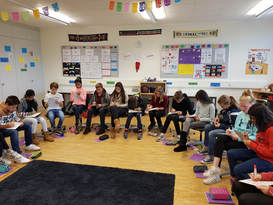 Reading and acquiring in the deskless class
Reading and acquiring in the deskless class I don't think it is 'me' in particular, but rather the comprehensible input methods I teach, which they have grown to love and cherish: storytelling, acting out parts of the book, movietalks, special person interviews etc. Is it so bad or so wrong that they are acquiring so much language so quickly that they are almost all acing every assessment they get? Is it not our goal to try and have highly motivated students as we know that will lead to achievement of their potential? Is it really my job to now go and set harder tests and evaluations so they don't all do so well, thus putting a lower number on some kids heads and demotivating them after all we have done to get this far together? I really hope not.
 Up and moving = increased engagement
Up and moving = increased engagement There is a cultural aspect to this too let's not forget. An 80% test score in an American school can mean a very different achievement level to an 80% score in a French or British school. The research is quite clear though, putting numbers on students heads, particularly low ones, demotivates much more than it motivates to improve. So why do we keep doing it? Why not just do away with grades altogether and just have comment only feedback for the first few years of secondary school (say up to age 15 or something). Is that really so radical?
And most importantly, should we not be celebrating the 'skewed' graph rather than trying to reset it?

 RSS Feed
RSS Feed